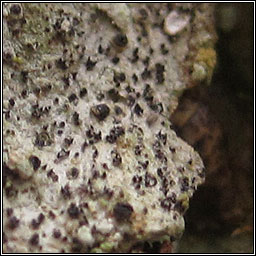
|
Monoblastiaceae
Anisomeridium polypori Growth type crustose. Chemical results negative Tolerant of deep shade and moderate pollution. Can be common on rough-barked deciduous trees in humid woodlands. Also found on shaded rocks, damp pebbles and bone fragments. A whitish or pale grey-green +/- inconspicuous thallus, sometimes with small perithecia (0.15-0.25mm). Black pycnidia usually abundant unless fertile, small with nipple or peg like tips. Conical macropycnidia most frequent, conical with ostilar neck and extruding a white tendril. Spores are 1(-3) septate, 14-20 x 4.5-5.5 Ám. Similar: Anisomeridium biforme. Perithecia 0.3-0.4mm, spores 1-septate, 12-16 x 5-7 Ám. Anisomeridium robustum is much larger |

Anisomeridium polypori
Holton Lee, Dorset. March 2013